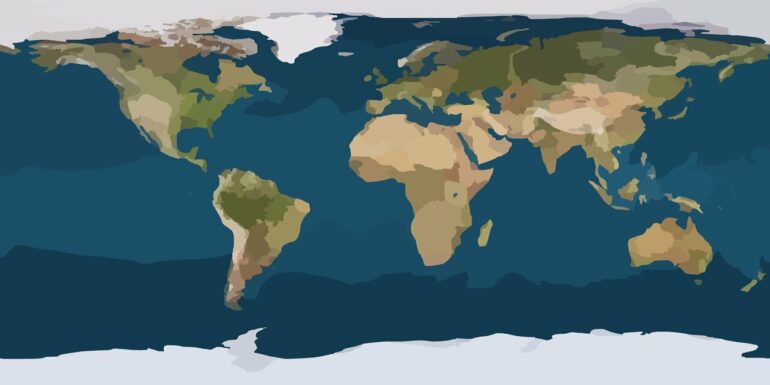Florida State University and Florida A&M University researchers are part of an international team that has identified a critical role the equatorial ocean plays in predicting the effects of climate change through a process known as ocean mixing.
The results of the team’s three-year study have been published in the journal Communications Earth & Environment.
“Accurately predicting the paths of major currents is necessary to predict ocean climate and subsequently, our entire climate,” said Xu Chen, a researcher with FSU’s Center for Ocean and Atmospheric Prediction Studies and FAMU. “There is such a strong exchange of water near the equator that it should be applicable to all parts of the vast equatorial ocean.”
Oceans are fundamental to scientists’ understanding of climate change. On a basic level, ocean waters absorb large amounts of carbon dioxide and heat from the atmosphere. But the mixing of ocean water—the change in properties including salinity, nutrients, gas and temperature that results from the mechanical force generated by winds, tides, cooling and warming—affects carbon and heat uptake as well as the large-scale ocean climate.
Ocean mixing primarily has been studied at the water’s surface because the surface interacts with weather events occurring just above it in the atmosphere, such as tropical cyclones. However, this study, the first of its kind, revealed the existence of key mixing pathways that exist far beyond the ocean’s surface and known boundaries.
Chen, along with Pierre Welander Professor of Oceanography and Environmental Science William Dewar and collaborators at the Chinese Academy of Sciences, used instruments such as acoustic Doppler current profilers and conductivity, temperature and depth sensors to record seawater temperatures, salinity levels, velocities and overall motion.
“Other recent studies have proposed pathways in which large-scale currents directly drive ocean mixing, but their results indicated that these pathways are limited to the ocean’s surface or topographic boundaries,” said Chen, who was a doctoral student under Dewar’s advisement when the study began in 2018. “Our study provides the first observational evidence and numerical validation of the existence of key mixing pathways far from the surface and boundaries.”
Chen, who continued this research as a postdoctoral researcher at COAPS and currently still researches there on a courtesy appointment, verified the data using Massachusetts Institute of Technology’s general circulation model, a numerical code that solves equations of motion occurring in the ocean or atmosphere.
If subsurface ocean mixing is strong, larger currents can dissipate, divide and transition into smaller currents in different directions, while weak mixing allows the current to continue its course. The strength of ocean mixing found in the study is related to the El Niño-Southern Oscillation, a yearly climate pattern that influences atmospheric circulation and dictates temperatures and precipitation across the globe.
The type of mixing seen in this study had been previously observed near the Kuroshio, a strong ocean current offshore from Japan that strongly impacts Asia’s climate.
The subsurface mixing observed in the study could occur near the equator because of the naturally different physical properties of the waters on either side of the equator. This area of strong interaction and mixing stretches between 200-400 meters below the ocean’s surface. Because the actual mixing of ocean water is extremely difficult, any mechanism that facilitates mixing is useful. Shallower waters can’t easily mix with deeper waters, so this vertical mixing is a significant observation.
“There’s not as much energy in the mixing below the surface as there is on the surface, but because the equator takes up such a large part of the ocean, something that would have a small effect based on energy has a much larger effect due to the vast area,” Dewar said. “Understanding the flow of these larger currents is essential to creating more accurate ocean models.”
Among the team’s next steps is investigating the mixing in the rest of the equatorial ocean and that specific link to ENSO, a critical index for global weather that indicates whether El Niño or La Niña will return each year. La Niña is the colder counterpart of El Niño, and the pattern between the two tends to shift every two to seven years.
Hui Zhou from the Institute of Oceanology, part of the Chinese Academy of Sciences, led the study and additional contributors include researchers from Pilot National Laboratory for Marine Science and Technology in Qingdao, Beijing Institute of Applied Meteorology, State Key Laboratory of Geo-Information Engineering in Xi’an, Laboratoire de Glaciologie et Geophysique de l’Environnement, and Scripps Institution of Oceanography.
More information:
Hui Zhou et al, Observations and modeling of symmetric instability in the ocean interior in the Northwestern Equatorial Pacific, Communications Earth & Environment (2022). DOI: 10.1038/s43247-022-00362-4
Provided by
Florida State University
Citation:
Subsurface ocean mixing near the equator significantly affects climate understanding and predictability (2022, March 8)



